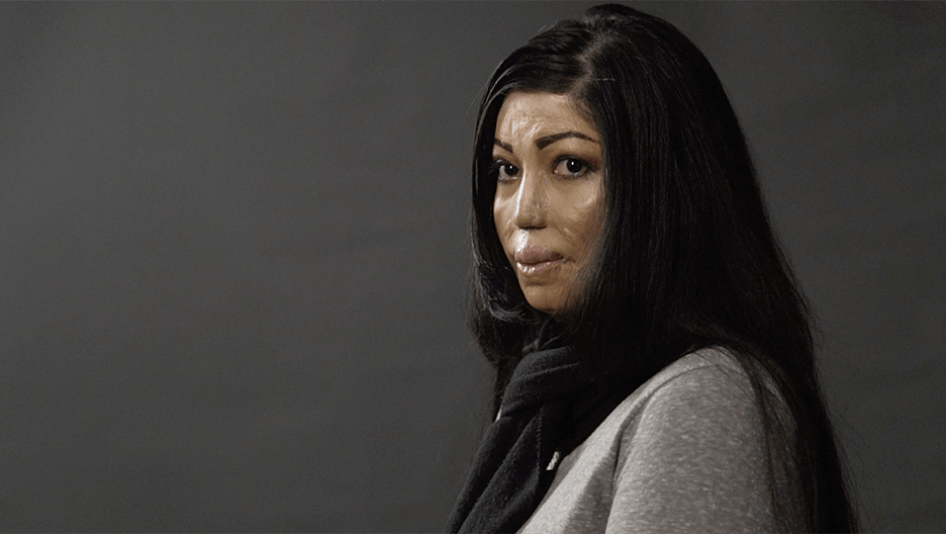Sitting on a thin mattress on the floor of their home in a Phnom Penh slum, 3-year-old Molita delicately touches the scars that cover her mother’s back. In November 2014, when Molita was an infant, the owners of a neighbouring market stall attacked her mother, Moung Sreymom, with highly concentrated acid. They doused nearly half her body, leaving penetrating burns covering Sreymom’s back, arms, legs, and half her face, melting off her right ear. As the acid continued to seep into her skin for days after the attack, Sreymom, then two months pregnant, had a miscarriage. Sreymom’s body had largely shielded Molita, who was with her at the time, from the bulk of the attack, but two burn scars run down Molita’s face—just missing her right eye.
Human Rights Watch spoke with Sreymom in June 2015 and again in May 2017. She described not only the unrelenting physical and emotional pain that she endures, but also the frustration, fear, and hopelessness of confronting a deeply flawed and corrupt legal system that has failed to bring those responsible to justice. In 2017, reflecting on her life after the attack, Sreymom said: “Now I know what hell feels like.”
This report—based on Human Rights Watch research in Cambodia between December 2013 and May 2017, and on desk and telephone research through June 2018—describes 17 cases of intentional use of predominantly nitric or sulfuric acid in violent attacks. Perpetrators are mostly private actors seeking to inflict pain, permanently scar, or kill the victims. While the Cambodian government has passed legislation to curb the availability of acid used in such attacks and to provide accessible health care and legal support to victims, perpetrators rarely go to prison and victims rarely receive adequate health care or meaningful compensation. The government’s failure to enforce the law or provide remedies for victims exacerbates their plight, with consequences that last a lifetime.
When concentrated acid is thrown on a person, it instantly melts through the skin and tissue, often down to the bone. Typically aimed at a person’s face, the acid quickly eats through eyes, ears, skin, and bone, dissolving flesh wherever it touches. Even if the acid is superficially washed off, it can continue to burn deeper into the skin and tissue for days. When Som Bunnarith’s wife threw acid on him in 2005, he thought that it was hot water, “but when I touched with my hands, I felt the skin melting from my face,” he explained. “For six months, I could smell the acid on my face when I would breathe in and out.”
In 2012, Cambodia passed an Acid Law requiring state hospitals to provide medical care free of charge for acid attack survivors. In practice, however, the law appears to be routinely ignored. Every hospital staff person interviewed by Human Rights Watch said that the victim would need to pay, and none indicated any knowledge of this clause of the Acid Law. In May 2017, even the head doctor at the burn unit at Preah Kossamak Hospital—the largest public hospital in Cambodia and the only one with a dedicated burn unit—was unaware that acid victims have a right to be treated free of charge. Not a single acid attack victim Human Rights Watch interviewed had received treatment free of charge at a public hospital. Instead, survivors face the full range of problems anyone in need of emergency and other serious medical treatment faces in Cambodia, including denial of treatment until they show proof that they can pay or provide out-of-pocket payments.
Acid attack survivors often require numerous surgeries in the ensuing years. Burn wounds can take years to heal, and without adequate medical care can leave thick scars that cause lifelong physical harm by severely restricting basic movement. The nose and mouth can fuse shut, the chin can fuse with the neck or chest, and eyelids can become stuck open. Victims of severe attacks often require dozens of operations over many years to remove these scars so that the individual can regain mobility. Even with access to proper medical care—which most of the people we interviewed did not have—blindness, hearing loss, and other disabilities are common.
Acid violence is rarely directly fatal. Rather, victims live on in physical, emotional, economic, and social suffering. Victims are often left with severe and permanent
Some survivors of acid attacks we interviewed in Cambodia said that the psychological impact of the attack was the most significant. Many expressed having had suicidal thoughts, even years after the attack. Some said they suffered from debilitating post-traumatic stress. Groups that have worked extensively with survivors said that suicide, attempted suicide, and chronic depression
Acid attack survivors have little likelihood of achieving justice in the courts. Victims of any crime in Cambodia typically cannot get meaningful attention from the police, prosecutors, or judges unless they have money to pay bribes or have influence. Should those responsible for the attack have positions of power, the chances of success are further reduced, and bringing a complaint could even be dangerous.
Corruption and negligence by the police also have a chilling effect on victims reporting cases. Women are dissuaded from reporting cases of domestic violence, for instance, out of fear that the police will do nothing, and that having reported the violence will put them in further danger. In some cases, such violence escalates and can include an attack with acid.
Because the general perception in Cambodian society is that acid attacks occur out of “love triangle” disputes, many people—including police officers and court officials—treat the victim, especially if a woman, as though they deserved the attack due to adultery or being the “mistress” of a married man. The severe scarring resulting from an attack serves as a permanent mark of their “guilt” that many survivors describe as making them feel further outcast from society.
Sun Sokney, who was attacked by her husband in a busy market in February 2016, said that people around her refused to help until she convinced them that she was the attacker’s wife, not a mistress. She added that until she convinced the crowd that she was his wife, they were cheering for him to run away to escape the police.
Perhaps the most infamous case of acid violence in Cambodia was the attack on 16-year-old Tat Marina in 1999. She had caught the eye of Svay Sitha, a 40-year-old deputy undersecretary of state in the Council of Ministers, who presented himself as a single businessman. Marina said that when Sitha’s wife, Khoun Sophal, learned of the relationship, she hired men to beat Marina unconscious and pour nitric acid on her face. No one was ever prosecuted for the attack on Marina—even though the assailants left behind identification—and she never received any compensation. Sitha currently serves as the undersecretary of state for the Office of the Council of Ministers.
Impunity prevailed not only in Marina’s
Key Recommendations
• Under the government of Prime Minister Hun Sen, in power since 1985, Cambodia’s healthcare and criminal justice systems have been beset by deep-rooted problems that prevent most Cambodians from obtaining adequate health care or having fair access to justice in the courts. These problems go well beyond the scope of this report. However, as detailed below, there are specific actions authorities can and should take to ensure that survivors of acid attacks get decent health care and a measure of justice. The government should:
• Revise the Criminal Code to make it a crime to obstruct the administration of justice, including by instructing or putting pressure on police, officials, judges, or prosecutors to act in a particular manner.
• Prohibit informal financial settlements in criminal cases, including those involving acid violence, that interfere with appropriate criminal prosecutions.
• Pass into law the long-promised draft victim and witness protection laws. Protection measures should include a program for the relocation of those at-risk, non-disclosure or limitations on the disclosure of information concerning the identity and whereabouts of witnesses, and evidentiary rules that permit witness testimony to be given in a manner that protects against harassment, intimidation, or coercion of the witness, while upholding the fair trial rights of the accused.
• Clarify the meaning of the provision of “legal support” under article 11 of the Acid Law as it relates to acid attack survivors. The government should act to ensure that this resource is provided and accessible to victims.
• Explicitly communicate to all public hospitals at all levels the legal requirement under article 11 of the Acid Law that all “state-owned hospitals or other state-owned health institutions shall provide support and treatment to the victim(s) of Concentrated Acid-free of charge.” Make clear to state hospitals that they will be reimbursed by the government for the costs of this free treatment.
• Ensure that opioid pain medications such as morphine and codeine are both available in adequate quantities and practically available for those who need them, in accordance with Cambodia’s obligations under the right to health.
Source: Human Rights Watch




